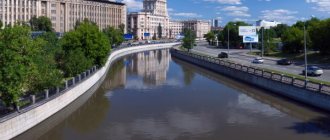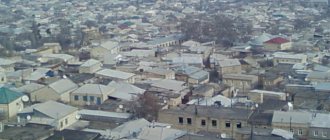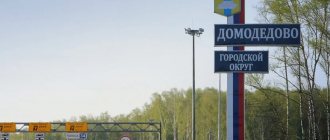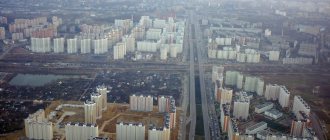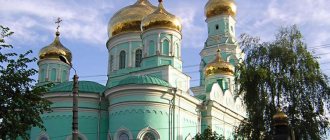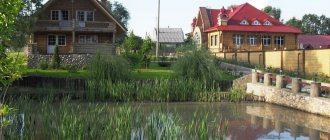Mytishchi
, a city of regional subordination in Russia, the administrative center of the Mytishchi urban district of the Moscow region, the center of the Mytishchi deanery of the Sergiev Posad diocese. Located on the western outskirts of the Meshchera Lowland, on the Yauza River and its tributaries - the Rabotnya and Sukromka rivers, 19 km northeast of Moscow. Railway station on the Moscow-Arkhangelsk line. The Moscow Ring Road adjoins the city borders. Sheremetyevo Airport is located in close proximity. Population 201 thousand (2016)
- On the map: Yandex.Map, Google map
At the end of the 16th century, the village of Loshakovo was located on this site. When the settlements that suffered during the Time of Troubles gradually began to revive, the peasants who lived near Loshakovo, behind the Yauzsky swamp, in the village of Zabolotye, decided to move to a drier and more convenient place. They moved their huts to the place where in ancient times they collected toll - the duty for transporting goods. Thus, on the Yauzsky “Mytishche” (from the word “myt”), a new village arose near the Pereyaslavskaya road, which was named Mytishchi. The wooden church of St. Nicholas the Wonderworker was also moved here from Zabolotye.
Since the peasant settlers previously lived on Losiny Island and were among the servants of the Trapper Path, which provided the royal hunt and monitored the protected forest, the part of the village of Mytishchi where they settled began to be called the Trapper Path and belonged to the royal court. The second half of the village belonged to the Trinity-Sergius Monastery. The church stood on the Trinity half of the village. By decree of the patriarch, it was ordered “the two villages of Ruposova and Sharapova, which were in the parish of the Church of the Epiphany, in the village of Nikolaevsky, ... to be in the parish, close to the Church of St. Nicholas the Wonderworker, in the village of Mytishchi.”
.
In the middle of the 17th century, the population of Mytishchi increased to 392 people due to the resettlement of peasants from other palace villages and hamlets here on the instructions of the Tsar. On the opposite bank of the Yauza, Zarechnaya Sloboda arose, and in 1683, a new settlement appeared near the Trinity Road - Novoselki, which later received the name Malye Mytishchi. From that time on, the village on the Yauza began to be called Bolshie Mytishchi.
By the end of the 17th century, the village of Mytishchi completely became a palace property. Its population grew steadily and by the end of the 18th century exceeded six hundred people. By the time serfdom was abolished, the village on the Yauza consisted of two parts - the village of Bolshie Mytishchi and Zarechnaya Sloboda with a total population of over nine hundred people. Its socio-economic situation also changed, which was significantly influenced by the opening of the Moscow - Sergiev Posad railway in 1862.
Personally, free peasants began to work in factories and factories, engage in trade, and carry out carriages. Inns, taverns, drinking houses, and shops began to open in the village. Several brick factories operated near Mytishchi, and in 1896 the Carriage Building Plant was founded, which later became a city-forming enterprise. In 1908, the Viscose artificial silk factory opened next to the plant. A workers' settlement grew up around the plant and factory. Thanks to the establishment of zemstvos in Mytishchi in 1872, the first zemstvo school in the Moscow district was opened.
From the 1913 census it is clear that at that time Mytishchi was a factory village with a population of seven thousand people.
Mytishchi workers took an active part in the revolutionary events of 1917. After the revolution and civil war, during the period of restoration of the national economy, the influx of workers began again in Mytishchi. This affected the quantitative and social composition of the village of Bolshie Mytishchi.
In 1919, Mytishchenskaya volost was renamed Proletarskaya.
On August 17, 1925, the city of Mytishchi was formed; at that time, over ten thousand people lived in it.
In 1932, the surrounding villages of Bolshie Mytishchi, Zarechnaya Sloboda, the villages of Perlovka, Taininka, Druzhba, the villages of Rupasovo, Sharapovo, Leonidovka, and Taininsky settlements were included in the city boundaries.
On November 25, 2015, Mytishchi received the status of a city of regional subordination, and the urban-type settlement of Pirogovsky was included within its boundaries.
Will Mytishchi become Moscow? What is known about this?
Geographically, Mytishchi is very closely connected with the capital, which has federal significance. The main point here is considered to be the fact that in this locality metro cars are produced, intended specifically for the Moscow metro.
Metrovagonmash operates in the city. Most of the population works here. Due to this, simply excellent social security for Moscow is guaranteed. Taxes paid by the local population go directly to the budget of the Moscow region. If Mytishchi is annexed to the capital, then all taxes, without exception, will be redirected specifically to the corresponding Moscow budget.
Taking into account the fact that the capital is experiencing a real and large-scale construction boom associated with the construction of the metro, a huge number of kilometers of completely new modern lines are constantly being opened. At the same time, outdated trains are being replaced. In any situation, the Moscow metro is constantly developing and improving. Here, it is often simply impossible to do without the use of new trains.
After the direct annexation of Mytishchi to the capital, the local enterprise will be able to make a significant contribution to the Moscow budget. Additionally, it is possible to implement such an important event as modern modernization. All this is necessary to increase huge turnover.
In addition to all this, between the local village and Mytishchi there is CHPP-27. Thanks to this, the territory is guaranteed to be supplied not only with electrical energy, but also with heat. Additionally, in this wonderful city there is also one of the branches of the University of Cooperation University. This is one of the most prestigious educational institutions today. By joining the capital, other local universities will also be able to significantly increase their own prestige.
There is also a corporate technical school on site. It is famous for the highest level of specialist training. It may also become part of Moscow in the future. As a result of this, it will fully correspond to its own name, and will also turn out to be one of the most prestigious throughout the capital.
The largest percentage of this city's population, approximately 90 percent, most often works in the capital. They pay taxes in the place where they were employed. In other words, the funds go directly to the capital’s budget.
If the urban area of Mytishchi is subsequently annexed to the capital, then we will talk about the underground Akulovsky water canal. Due to this, the capital will be provided with clean drinking water. As a result of joining, the residents themselves can gain access to a dynamic and constantly developing infrastructure. All this also applies to such areas as transport infrastructure. Thanks to this, it is possible to significantly improve the transport connectivity of this city with the Moscow Ring Road, as well as with the Yaroslavl Highway.
It is also possible to significantly extend the local metro line. The local population will also receive a full package of much-needed social security, which is typical for residents of the capital.
Today it is proposed to annex the entire urban area. A village called Chelobitevo is not excluded. We can also talk about territory belonging to a town like Korolev. The area is about 14.5 hectares. It is also proposed for inclusion in the composition.
Without fail, it is worth taking into account that the city also contains such quite important objects as, for example, a military unit. Other similar objects cannot be excluded. An appropriate decision must be made here. Such territories can either become part of the capital or remain part of the Moscow region. Naturally, all this applies to the local water utility.
But the remaining part of the district is planned to be transferred to the Pushkinsky district. According to numerous forecasts, all this will be transformed from a municipal district into a real urban district. All this is due to the current trend. Some parts of the territory may be transferred to a nearby city called Korolev. All of the above was reflected in the corresponding petition.
Historical reference
The history of the region goes back centuries. The first inhabitants - tribes of Neolithic hunters and fishermen of the Lyalovo culture - appeared here back in the 4th millennium BC. e. In the Bronze Age (2nd millennium BC), cattle breeders and metallurgists of the Fatyanovo culture lived on the Mytishchi land, and in the Iron Age (1st millennium BC) they were replaced by tribes of the Dyakovo culture, who built fortified villages on river capes , were engaged in cattle breeding and agriculture, and mastered iron production.
The Slavs - Vyatichi and Krivichi - came here at the end of the 1st millennium AD. e. In the area between the Ucha and Klyazma rivers there was a conventional border between these tribes; here was the zone of their mutual penetration. Mixed burial mounds with Vyatic and Krivik burials are known. In the ancient Russian era, the Mytishchi region was quite densely populated. Now there are 12 settlements and settlements known here from the 9th to the 13th centuries, one of which is located on the banks of the Yauza within the boundaries of the modern city of Mytishchi. The Slavs brought with them a developed culture of arable farming, raised livestock, and were well acquainted with various crafts - metallurgy, blacksmithing, pottery, carpentry, and jewelry.
In the 11th - 14th centuries, an important trade waterway passed through the Mytishchi land along the Yauza and Klyazma rivers. This path has existed since time immemorial, long before the founding of Moscow. At the place where Mytishchi is located, there was a collection point for passing duties from people and ships, which bore the general name - myt. “Yauza Mytishche” was first mentioned in the spiritual letter of the monk of the Simonovsky Monastery Adrian Yarlyk, dated July 1460. From Yauza to Klyazma, merchant ships were dragged overland over a distance of about 7-8 kilometers. The name of the city is associated with this trade route. The diagram of the ancient portage is shown on one of the stands of the local history museum.
In 1623-1624, in the scribe book of the estates of the Trinity-Sergius Monastery of the Moscow district, Mytishchi is mentioned: “The village of Mytishchi was half the village of Loshakova on the river in Mytishche, and in it there was a church on the Trinity half in the name of St. Nicholas the Wonderworker.” In 2003, Mytishchi celebrated 380 years since its first mention as a village.
Within the city of Mytishchi there is the ancient village of Taininskoye (formerly Toninskoye), known since the beginning of the 15th century, - the hereditary patrimony of the great Moscow princes and Russian sovereigns, which served as their country residence. Rich palace chambers and outbuildings were erected here. This village near Moscow was the favorite estate of Ivan the Terrible, one of the centers of the oprichnina. Tsar Alexei Mikhailovich often visited here on his way to a pilgrimage to the Trinity-Sergius Lavra and rested in a specially built “travel palace.” By his decree, in 1675-1677, a stone manor church of the Annunciation, unique for Russian architecture, was erected next to the palace. Empresses Elizaveta Petrovna and Catherine II visited Taininsky.
In 1749, on the site of more ancient buildings, a new wooden palace was built in the then fashionable “Chinese style”, new residential and utility buildings appeared, and the palace garden was re-laid. At the end of the 18th century, the estate was abandoned and gradually fell into disrepair. Its destruction was completed by the great fire of 1824.
The upper reaches of the Yauza River have long been famous for its spring water. It was from here that the construction of the first Moscow gravity water pipeline began in 1779. Construction lasted 25 years and was completed in 1804. The water pipeline was quite a complex engineering structure for that time. Water from 28 key wells flowed into a brick-lined gallery that stretched 19 miles to Moscow. The Rostokinsky aqueduct has survived to this day - in the place where the water pipeline gallery crossed the Yauza riverbed.
In the second half of the 19th century, industry began to develop rapidly in the urban district of Mytishchi. Plants and factories were built mainly near the Northern Railway line, built in 1862. In 1897, the carriage building plant produced its first products, and in 1909, the first artificial silk factory in Russia, Viscose. Gradually, a large industrial center emerged in the village of Bolshie Mytishchi. There was also a railway junction here.
In 1922, a “working garden city” was founded - the village of Druzhba and the village of Tabachnik (Leonidovka microdistrict), etc. By 1926, the population exceeded 10 thousand people.
In 1925, Mytishchi received city status. During the pre-war five-year plans, the appearance of the city changed greatly due to the commissioning of a new hospital building, a car factory club, and a sculpture factory (art casting plant). The chemical industry began to develop on the basis of the Viscose factory.
From 1932 to 1937, the route of the Moscow Canal, the world’s first energy canal, passed through the territory of the region. In 1932, the villages of Rupasovo, Sharapovo, the villages of Bolshiye Mytishchi, Taininskoye, Zarechnaya Sloboda, the villages of Perlovsky, Taininsky, Leonidovka and Druzhba were included within the city limits. There was a need to build new microdistricts, but the war prevented the implementation of these plans.
During the Great Patriotic War, residents of the city and region contributed to the overall victory over the enemy. Over 45 thousand Mytishchi residents went to the front. More than 20 thousand of them did not return from the battlefields. All enterprises switched to the production of military products. 6 hospitals were deployed and a fighter battalion was formed. The “Mytishchi Collective Farmer” tank column and the “Moscow” air squadron were built at the expense of the region’s workers. Thousands of Mytishchi residents were awarded orders and medals, 22 were awarded the title of Hero of the Soviet Union, three became full holders of the Order of Glory. Among them A.I. Egorov, A.I. Kadomtsev, N.P. Seleznev, M.I. Tolmachev, N.M. Raspopova, V.I. Karpenko, I.A. Korablin and others.
Mytishchi: what can you say about them?
Mytishchi is a rather beautiful city. It will become even better if it becomes part of the capital. There is a lot of greenery here, and there are also numerous places for relaxation. This all goes well with a well-developed infrastructure, as well as a modern style.
The city arose a long time ago. This happened back in the second half of the 15th century. In those days there was a trade river route. To get there you had to go through quite a large area. It was not possible without paying a special duty. At that time it was customary to call all this in one word - “washed”. And the population that appeared in these places, as a result, began to be called Mytishchi. All this denotes a real place intended for collecting food.
The urban settlement is located 19 km from the central part of the capital. It is considered a satellite city of a river like the Yauza. It is also considered one of the largest industrial centers. On the territory of the city there are also various places that are usually classified as cultural heritage. The climatic conditions here are quite good. In winter, the average temperature is around -10 degrees. As for snow, it most often falls here in a month like November. Industry itself is well developed in the city. There are places where you can get a job.
Will Mytishchi be annexed to the city of Moscow? No one knows all this for sure. Although, more than one thousand people want all this.
Used materials
- “City district today. General information", website of the Mytishchi Urban District:
- History of the Mytishchi Vladimir Church on the official parish website
- “Mytishchi”, website People's Encyclopedia of Cities and Regions of Russia “My City”
- “Mytishchi district”, page of the official website of the Moscow diocese:
- “Mytishchi, churches and monasteries”, website “People's catalog of Orthodox architecture”:
[1] Journal No. 4 of the meeting of the Holy Synod of the Russian Orthodox Church dated April 13, 2021,

